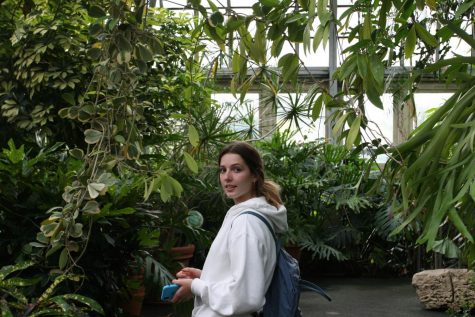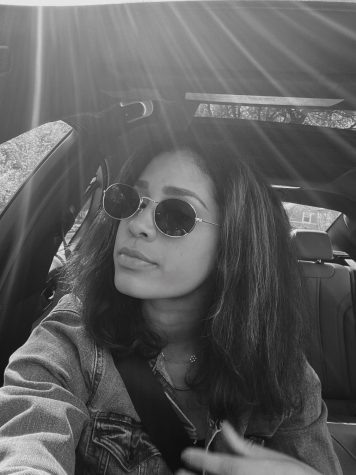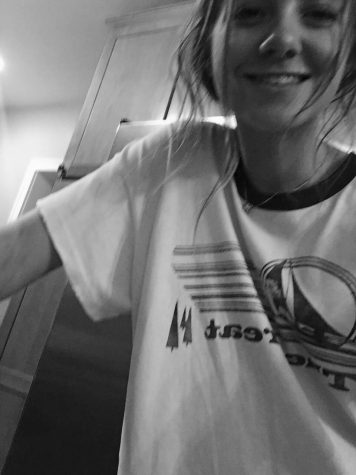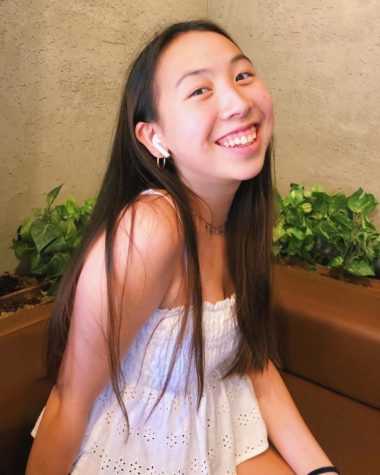Artist Spotlight
November 19, 2018
Izzy Colbert
By Sophie Monzo Entertainment Editor
Budding artist and senior Izzy Colbert uses their art for activism. Interested with art since kindergarten, their work primarily consists of drawings and paintings, but they’ve dabbled into other visual art forms such as ceramics and wood burning.
“I was always into art as a kid, creating things, destroying them, really just like any other kid,” Colbert says.
Colbert’s kindergarten teacher showed their class a collection of abstract work from Artist, Jackson Pollock, shaping a passion for their art.
Colbert has taken multiple art classes offered by the school. Colbert explained that as much as they love art and is fully passionate about it, they choose to make their art with a deliberate purpose in mind.
“I don’t like making boring art, so I’m not one to create art just because I haven’t in a while or because I feel obligated to,” Colbert says. “I create art when I want to, when I’m inspired.”
Inspiration for their work stemmed from this intersectional background and identity. They hope that their work can advocate for marginalized groups, especially since many of these identities have been subjected to violence both in the past and recently.
“I exist in this world as a unique individual. I am black, Native American, queer, transgender and nonbinary,” Colbert says.
Along with the ETHS art classes, other inspiration for Colbert has come from their work at the Art Institute of Chicago, where they took pre-college courses through Art Institute.
“This class completely redefined the way that I look at art,” Colbert says. “It made me excited to push the boundaries of what drawing can be.” At the Art Institute, Colbert’s art was chosen to be put into the school’s online art exhibition.
Colbert’s work has even gone on to be noticed by SNCKPCK, a musician on instagram, using a piece of their work to inspire a poem. The musician would go on to use Colbert’s work for SNCKPCK merchandise.
While the future seems far, Colbert knows that they want to continue art. They want to possibly become a freelance artist and have the ability to sell their art. Colbert still wants to use art as a form of activism for years to come.
Julia Shoaf
By Madison McGuire
Staff Writer
Art is activism, painting inspires people.
Senior Julia Shoaf’s business, Paint it Back, blends art, fashion and speaking together with a new perspective.
“I started painting junior year and I came into my self-reflection phase of what it means to be a white woman,” Shoaf says. “I had to advocate for everyone so I took my paintings and decided to do something with it.”
Paint it Back is Shoaf’s self created and run brand. Her business focuses on painting messages of activism on the back of thrifted jean jackets.
“People own the design and start talking to other people about their jacket. It creates more courageous conversation between people,” Shoaf says. “It inspires change, and people engaging in their community.”
On her jackets, Shoaf has shed light on subjects such as Black Lives Matter, prison education, gun control and clean water. Last year, senior Liana Wallace wore one of Shoaf’s jackets at the Gun Control walkout reading “Hands Up Don’t Shoot” during her spoken word performance.
“I definitely get inspiration mostly from protest posters,” Shoaf adds, “I try to do some type of graphic then with it.”
Paint it Back’s mission is to give back to the community through art and activism. She tries to sell her jackets sell for roughly $40 – $50 each, $25 of which she donates to the non-for-profit Social Work Chicago. Shoaf decided on Social Work Chicago because she wanted her work to directly affect the local community. Social Work Chicago’s focus on CPS schools and providing resources to classrooms and students seemed like the obvious choice.
“I want to have an affect on the community. I am painting the jacket back to life and also painting it back to the community through donations,” Shoaf explains.
Dylan Anderson
By Sophie Yang
Staff Writer
Dylan Anderson is an aspiring photographer with dreams to explore the world of photography through his Canon 50mm lens. Anderson is a senior with 2,000 Instagram followers on his photography account.
“I’m definitely going to try and pursue [photography],” Anderson says. “I’m planning to go to art school. Ideally an art school in New York.”
His career began in sixth grade, after receiving his first digital camera from his mom. After messing around with it and eventually taking a photography class at ETHS, his interest grew, and turned into something much more than just a hobby.
“I kind of want to get into fashion photography or something, and do it as my profession,” Anderson says.
He mainly shoots portraits and some landscapes, usually just for his friends, but currently his main inspiration is trying to capture precious moments before heading off to college.
“I’m trying to take photos of everything before I go to college, I’m just trying to hold onto stuff,” Anderson says.
At the moment, Anderson is working on his artist’s portfolio. This includes writing a statement about his work, and putting all the pieces together. His past projects include shooting the Söda lookbook, which helped introduce him to fashion photography. Anderson talked about how it was a big step for him and introduced him to a whole new world of photography.
“My two friends Effie and Owen have a little fashion company called Soda, we hung out and talked about what their brand meant to them, and made something together.”
Dylan often has ideas prior to the shoot, but lets the creativity flow and enjoys making something beautiful while connecting to his subject.
He is also exploring the possibilities of the film world and has made a few short videos, showcasing his interest through youtube.
He talked about how often social media is distracting, and pulls away from the focus of his own ideas.
Dylan’s advice to anyone interested in following his footsteps would be, “Do what fits you best, and only shoot what you really want to shoot.”
Effi Jacobson
By Sophie Monzo Entertainment Editor
Fashion designer junior Effi Jacobsen is trying to shift the fashion culture with her brand Söda, which she started around six months ago.
The brand was originally something that was made just for fun.“With the weight that brands carry, we wanted to see if we could do it,” Jacobsen says.
Inspiration for Söda has come from a variety of places. Personally, Jacobsen has taken interest in designer Ava Nirui. Nirui has been known to not follow high fashion brands. “She pokes on the hypebeast culture,” Jacobsen says. Hypebeast culture is someone that follows the trendy styles and brands of today, like Supreme.
Jacobsen explains that her inspiration can also come from just walking the hallways. “I like seeing it around me,” Jacobsen says. “People using clothing to identify themselves.”
The label explores the use of chains and sparkles on clothing, putting their take on the hypebeast culture that is so prevalent today.
While the brand is young, Jacobsen has been involved in fashion for years before, like sewing her own clothes. This started when her dad got her a sewing machine two years ago and taught her how to sew. “I feel like this is the best way to have unique clothes,” Jacobsen explains.
While the future of Söda is still unknown, Jacobsen is proud of the work she has been able to put out. “I like the idea of doing something that we started and finished,” Jacobsen says.
Jacobsen hopes to pursue fashion and design in her future with thoughts of design school, as well as working Chicago fashion week this year.
Emma Barreto
By Madison McGuire, Nora Miller
Staff Writers
What started off as a project for Fashion Institute of Design and Merchandising, senior Emma Barreto’s styling website, Opal, has taken since off.
“Opal was all about environmentally friendly clothing consumption, personal style and expression in the most equitable way,” Barreto says.
The portfolio and application began in 2017 with an idea of a website which focuses on thrifted clothing items. Barretto has used Opal as a way to channel her ideas in the fashion industry, while simultaneously creating a project she was passionate about.
“I wanted gender, racial and size diversity in my project and did my best to put all of my energy into making that real,” Barreto explains.
Prior to meeting models, she does not have any prior ideas or sketches, but found unique pieces and built the rest of her looks around the models she chose. Opal’s diversity developed it into an inclusive and well-rounded website.
Executing her vision was the hardest part of the process, as she had to hire photographers, choose locations and tell the models how to pose and act. Barreto had to work indepdently for this part of the project.
“If you have the ideas and the drive, having an end goal and a vision that you’re constantly growing on is definitely a step in the right direction,” Barreto says.
Barreto shared that she does not plan on continuing or growing Opal into anything more than it already is. She views it as a successful first project and hopes that it can serve as a template for younger people aspiring in styling.












